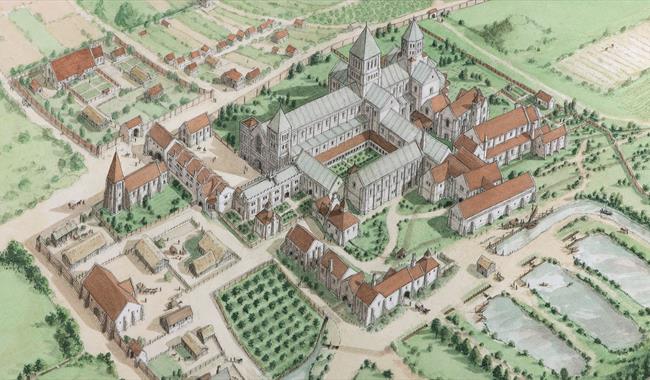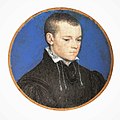Yesterday evening, thanks to Zoom, I was able to attend the Lewes Priory Trust’s fortieth annual Emil Godfrey lecture on the history of this major Cluniac foundation. The speaker was Professor Sir Diarmuid MacCulloch and his subject the very significant part played in 1537 by Thomas Cromwell in securing the dissolution of Lewes Priory and his acquisition of it as the proposed site of a house for his eighteen year old son Gregory and his new wife. Elizabeth, who was aged about twenty or twenty one.
Elizabeth was not just a new spouse but already a mother and the widow of a knight and hence Lady Ughtred. Much more significantly she was a younger sister of the Queen, Jane Seymour, with all that portended. Although the Queen died in October Gregory was uncle by marriage to the heir to the throne. Gregory appears to have been the apple of his father’s eye, fashionably educated and, in 1537, a young man with serious prospects.
Thomas Cromwell by Hans Holbein the Younger.
The miniature is from 1538 or later as he is schoen wering the Order of the Garter.
Image: Wikipedia
Thomas Cromwell appears to have negotiated an arrangement with the Duke of Norfolk whereby the Lord Privy Seal gave up his interests in Norfolk in return for a free hand in Susssex where the Duke, owner of the dilapidated castle at Lewes had very few
( Arundel had not yet been inherited and become part of the Howard portfolio )

Reconstruction of Lewes Priory
Image: copyright Andy Gammon 2010/ Visit Lewes
With the surrender of much the wealthiest Cluniac house in the country by a suitably accommodated ( i.e. bribed ) community the Italian born Giovanni Portinari was sent down to Lewes and recorded the blowing up of the priory church in his role as a demolition expert and, in his capacity as architect, doubtless set about planning a Renaissance residence in the style favoured by the Seymours for Gregory and Elizabeth, who arrived early in 1538 and apparently lived in the former Prior’s lodging
A miniature believed to be of Gregory Cromwell by Holbein
Image: Wikipedia
Portrait believed to be of Elizabeth Cromwell by Holbein
Image: Wikipedia
However the best laid plans do often go awry. Gregory, his wife apparently already pregnant when they married, now appears to have got involved in a serious and scandalous liaison that resulted in him being ordered to perform a public penance by words and s generous distribution of loaves on e Sunday after the main Mass in Chichester Cathedral. This agreed, Gregory refused to go through with it, to the shock of the Bishop, his cousin and mentor Richard Cromwell and probably Sir John Gage of Firle, who seems to have had a place as moral tutor to the erring youth.
The result was that Gregory and Elizabeth were rapidly re-located to Leeds Castle in Kent, and he rapidly became one of the two MPs for the county. Lewes as a project was abandoned and in 1540 Thomas Cromwell was toppled - by the Duke of Norfolk and others.
Partially rescued by his wife by the end of the year he had been created Baron Cromwell in his own right ( not to be confused with the late medieval Cromwell barony, then in abeyance and revived about a century ago ). Gregory died at his father’s other landed acquisition from the dissolution, Launde Abbey in Leicestershire, in 1551. His monument in the chapel is an outstanding example of early Renaissance art.
All this and more was presented in the elegant and informed way that those of us who have had the privilege of hearing Sir Diarmuid lecture before have come to expect, Three years ago his four public lectures on Thomas Cromwell here in Oxford in advance of the publication of his magisterial biography were marvellous in their command of detail and the wider picture. At the end of his talk the Professor did say the whole story of the Cromwells and Lewes is to be found in that book.
In addition the Wikipedia account of Gregory is exceptionally detailed and fascinating in itself. It can be read at Gregory Cromwell, 1st Baron Cromwell





No comments:
Post a Comment